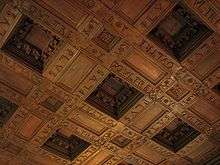Plus ultra (motto)
.svg.png)


Plus ultra (/ˌplʊs ˈʊltrɑː/, Latin: [ˈpluːs ˈʊltraː], Spanish: [plus ˈultɾa]; Latin meaning "further beyond"; in Spanish, más allá) is the national motto of Spain. It is adopted from the personal motto of Charles V, Holy Roman Emperor (and King of Spain as Charles I) which is derived from the opposite Latin original Non plus ultra, which means "Not(hing) further beyond". While "Plus ultra" means the political ambition of the Holy Roman Empire to become a world power after the European discovery of the Americas by Christopher Columbus, "Non plus ultra" got the meaning of "Nothing better" (top notch, unbeatable) in a common sense.
Charles V
According to Earl Rosenthal, author of The Palace of Charles V in Granada (1985), the motto is closely associated with the Pillars of Hercules, which, according to Greek mythology, were built by Hercules near the Straits of Gibraltar to mark the edge of the then known world. According to mythology the pillars bore the warning Nec plus ultra (also Non plus ultra, "nothing farther beyond"), serving as a warning to sailors and navigators to go no farther.
It is believed that the young Charles V adopted Plus Oultre as his motto at the suggestion of his doctor and personal advisor Luigi Marliano. The idea was to encourage him to ignore the ancient warning and to take risks, surpass himself and go "farther beyond" especially over the Atlantic ocean to America.
It has also been interpreted as a phrase used to transcend nationality as Charles ruled over many different parts of Europe (particularly as Holy Roman Emperor) and colonies all over the world.
Spanish Empire
The motto became popular in Spain after Charles V became king of both Aragon and Castile in the early 16th century. It subsequently became the motto of Habsburg Spain and featured on the Spanish dollar as well as Habsburg propaganda in Europe. The motto was used to encourage Spanish explorers to go beyond the Pillars of Hercules and on to the New World. Today the inscription, along with the Pillars of Hercules, is featured on both the national flag and emblem of modern Spain. It was also featured on the shield of the Second Spanish Republic.
Other use
The motto has been adopted or used by a number of institutions around the world including UNAM in Mexico, Jurong Junior College in Singapore, Malden Catholic High School in Massachusetts, Newstead Girls College, the oldest existing public school in Sri Lanka, the Colombian Navy, the secondary school in Trompsburg, and the Soddy Daisy High School baseball team. It was used as Sir Francis Bacon's personal motto. It is also the motto of Immanuel College in South Australia and St Peters Lutheran College in Queensland.
In its Old French original version, Plus Oultre is the motto of the Belgian municipality of Binche and the motto of the United States Air Force Academy's 15th Cadet Squadron.
Charles V was born in Ghent in Flanders and as a result the motto is also used in this region.
In 1926 a crew of Spanish aviators, including Ramón Franco and Julio Ruiz de Alda Miqueleiz, completed a Trans-Atlantic flight on a seaplane named the Plus Ultra. 1930 saw the formation of a Madrid-based football team AD Plus Ultra, which eventually developed into Real Madrid Castilla.
In 2003, the Plus Ultra Brigade was a brigade of troops from five Spanish-speaking countries including Spain, the Dominican Republic, Nicaragua, Honduras, and El Salvador, which served in the Iraq War.
The motto is also used in the manga and anime Boku no Hero Academia, where the hero characters depicted are meant to perform "further beyond" in bravery.